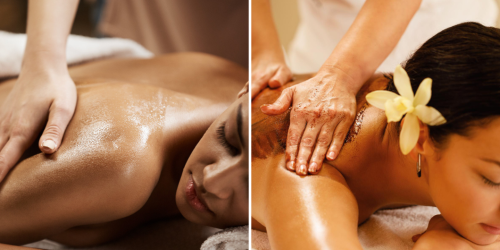Abhyanga is as popular as ayurveda itself. Generally viewed as a means to relaxation, this wonderful procedure, when done right, has a host of benefits ranging from good sleep to keeping the eye sight intact. As a part of dinacharya, the emphasis is amplified through the verse “abhyangamacharet nityam…” to state that it must be done daily. It is essential to note that abhyanga is not simply ‘massage’ or kneading the body in any way. It is a set of techniques laid down by Acharyas. Not all massages are abhyanga. It is also an important part of panchakarma. To the learned Vaidya, abhyanga is both diagnostic and therapeutic.
Udwartana on the other hand is the procedure of rubbing ground medicaments (coarse powder) after vyayama or exercise. It helps in release and trapping of the dosha and sweda (sweat). Today, it is a go-to technique included in management of obesity and for slimming. As opposed to abhyanga, udwartana is done in pratiloma gati (from below upwards). But both procedures are to be done in an empty stomach. Thus, abhyanga and udwartana are mutually complimentary and help in revitalizing the circulatory and nervous systems, daily!
Ayurveda perspective
Abhyanga
Once all the impurities are gotten rid of (from mala visarjana until dhumapana), the next step is that which increases the strength of the entire body whilst also having far fetching advantages. This is especially to be done before any exercise or as a preworkout routine. Abhyanga includes application of lukewarm (medicated) oils (or ghee) to the body based on the disease/ health condition, the rutu (season), vaya (age) etc. oils such as Dhanwantara taila, ksheerabala taila, kottamchukkadi taila etc are used.
The oil gets absorbed into the circulation through the skin (srotas/channels). Depending on the target of action (dhatu), the time duration taken is explained in matra kaala. Benefits of abhyanga include delayed ageing, a lustrous and healthy skin, relieve fatigue and stress, improves eyesight and sleep, nourishes the body tissues, strengthens the muscles and bestows a firm and strong built. Better circulation to complex structures such as joints helps in better flexibility. Special care is given to ears, chest, joints, head and neck whilst massaging.
Abhyanga and hridaya: this practice directly helps in regulation of vyana vata without which circulation and nervous conduction cannot take place properly. With better circulation, the muscles relax; the mind relaxes, and helps in prevention and reduction of blood pressure. Stress (and anxiety) being a cause and risk factor of heart diseases is effectively countered. Anti-ageing factor helps in preventing senile disorders which generally affect the heart. Based on the taila used, abhyanga also acts on hyperlipidemia and obesity.
Udwartana
After abhyanga, one is directed to exercise. After exercise, coarse powders of Kolakulatthadi churna, Kottamchukkadi churna, Triphala churna etc are used after mixing with oils in smaller quantities or without any lubrication. This helps in opening the srotas (channels) blocked by kapha, kleda, medas and such. Udwartana brings about vilayana or liquefying of dosha/ medas (fat) which coats the srotas. The procedure of rubbing powders is again of different type’s base on the force of application, target action, mixing with oils etc. In general, udgharshana is a completely dry procedure whereas udwartana is party dry and partly unctuous. Utsadana is a predominantly snighda procedure.
Udwartana and Hridaya: Hyperlipidemia and atherosclerosis are the leading causes of heart diseases. To counteract blocking of arteries, a non-invasive technique such as udwartana can be practised easily, daily. It helps combat / avoid obesity, stimulates circulation and nerve endings, relieves stress, and stimulates muscles especially helpful in the aged and diseased. It helps reduce and keep away the body odour, regulates sweating and exfoliates the skin. Similar to abhyanga, it influences vyana vata. Also affects kapha and bhrajaka pitta. It is a simple detoxifying procedure which can be practised daily.
Both abhyanga and udwartana effect circulation, conduction and lymphatic drainage. Depending on the drugs used for the procedures, they influence the working of heart by reducing bad fats, increasing reach of blood and nutrients and getting rid of wastes. These act both physical and psychological planes. They can be used as alternative pain relievers.
Western perspective:
Massage therapy can help reduce the dependence on pain-relieving medications in a number of different circumstances and medical ailments. Massage therapy as part of a health and wellness program, in addition to other contexts, is a side effect-free method of pain reduction that can be a valuable part of one’s treatment plan, such as post surgery, in PTSD and other anxiety conditions, to replace pain medications etc1. However, these are generally bunched under physiotherapy and other alternative practises.
Conclusion
The techniques of abhyanga and udwartana are age old traditions which are also a part of festivals (Deepavali abhyanga snana) in India. These are cost-effective, guaranteed ways of achieving health, longevity and preventing cardiovascular disorders in the long run. A sculpted physique with a fit heart and stress free life do not seem farfetched with daily abhyanga and udwartana!
References:
Author
Spoorthy S Naik
Ayurvedic Cardiac Consultant
Sriranga Ayurveda Chikitsa Mandira, Dattagalli, Mysore.



